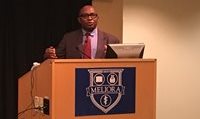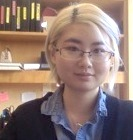News
Repurposed drugs may offer improved treatments for fatal genetic disorders
Wednesday, December 21, 2016
Department of Biomedical Genetics researchers believe they have identified a new means of treating some of the most severe genetic diseases of childhood, according to a new study in PLOS Biology. The diseases, called lysosomal storage disorders (LSDs), are caused by disruptions in the functioning of the stomach of the cell, known as the lysosome. LSDs include Krabbe disease, Gaucher disease , metachromatic leukodystrophy and about 40 related conditions. In their most aggressive forms, they cause death of affected children within a few years after birth.

Nicole Scott-Hewett

Christopher Folts
The research was spear-headed by Nicole Scott-Hewett and Chris Folts, two recent graduates of the program in Genetics, Development and Stem Cells. Led by the article's corresponding author Mark Noble, Ph.D., the team discovered for the first time how specific toxic waste products that accumulate in LSDs cause multiple dysfunctions in affected cells. They also found that several drugs already approved for other uses have the unexpected ability of overcoming the cellular toxic build-up, providing new opportunities for treatment. Key to this discovery was the finding that these drugs can help restore normal acidification of the lysosome.
In a mouse model of Krabbe disease (one of the most severe LSDs), Drs. Folts and Scott-Hewett found that their lead study drug, colforsin, increased survival as effectively as in studies where disease-causing mutations were corrected by gene therapy. Colforsin is approved in Japan to treat cardiac disease, which provides information to investigators about its use in humans.
Increased survival in mice occurred even though treatment was started later than is necessary for gene therapy. The research treatment also decreased damage to the brain and improved the quality of life in the diseased mice. All of these outcomes are critical goals in the treatment of children with Krabbe disease or related illnesses, said Noble, who is the Martha M. Freeman, M.D., Professor in Biomedical Genetics at URMC.
"One of the great challenges in these diseases is that they are both rare and come in many different varieties, and advances have tended to focus on single diseases," Noble said. "In contrast, our findings suggest our treatments will be relevant to multiple disorders. Also, we saw benefits of our treatment even without needing to correct the underlying genetic defects. That gives us great hope that we could combine our treatments with other candidate approaches to gain additional benefits."
If the results can be translated into humans, Noble said, the repurposed drugs might improve the quality of life for afflicted children while more difficult experimental genetic treatments are pursued. The complete study can be found at: PLoS Biology
Repurposed Drug May Offer Diagnosis, Treatment for Traumatic Nerve Damage
Monday, November 14, 2016
Researchers at the University of Rochester Medical Center believe they have identified a new means of enhancing the body's ability to repair its own cells, which they hope will lead to better diagnosis and treatment of traumatic nerve injuries, like those sustained in car accidents, sports injuries, or in combat. In a study published today, the team showed that a drug previously approved for other purposes can 'wake up' damaged peripheral nerves and speed repair and functional recovery after injury.
The study appearing in EMBO Molecular Medicine, demonstrates for the first time that 4-aminopyridine (4AP), a drug currently used to treat patients with the chronic nerve disease, multiple sclerosis, has the unexpected property of promoting recovery from acute nerve damage. Although this drug has been studied for over 30 years for its ability to treat chronic diseases, this is the first demonstration of 4AP's benefit in treating acute nerve injury and the first time those benefits were shown to persist after treatment was stopped.
Study authors, Dr. John Elfar, associate professor of Orthopaedics, and Mark Noble, Ph.D., Martha M. Freeman, M.D., Professor in Biomedical Genetics, and their laboratory team, found that daily treatment with 4AP promotes repair of myelin, the insulating material that normally surrounds nerve fibers, in mice. When this insulation is damaged, as occurs in traumatic peripheral nerve injury, nerve cell function is impaired. These researchers found that 4AP treatment accelerates repair of myelin damage and improvement in nerve function.
6th Annual Stem Cell and Regenerative Medicine Symposium
Monday, June 27, 2016
Dr. Jack Kessler
In celebration of the NYSTEM-funded training program in stem cell biology at the University of Rochester, researchers convened for a day of presentations and discussions on advances in stem cell biology. To emphasize the excellence of our junior scientists, five NYSTEM trainees (both pre- and post-doctoral, took turns with leaders in the field of stem cell medicine to present their work. The meeting kicked off with a presentation by Dr. Jack Kessler, Northwestern University Feinberg School of Medicine) describing the factors controlling adult neural stem cell maintenance -- a key determinant of cognitive health.

Dr. Kunle Odusi
Dr. Angela Christiano (center)
Dr. Kunle Odunsi (Roswell Park Cancer Institute) spoke in his role as director of the immune-therapy program on the importance of gene-engineered, tumor recognizing CD4 T-cells in anti-tumor therapy.
Dr. Angela Christiano (Columbia University) provided an impressive example of the power of iPSC technology with the development of 3D-skin tissue for treatment of such devastating skin diseases as epidermolysis bulbosa.
NYSTEM Trainees
Presentations by NYSTEM trainees Fanju Meng (Biteau lab), Wenxuan Liu (Chakkalakal Lab), Michael Rudy (Mayer-Proschel Lab), Dr. Andrew Campbell (Proschel Labs), and Dr. Nicole Scott (Noble Lab) rounded out a day full of exciting new work that highlights the broad impact of stem cell biology on medicine today -- and the success of the SCRMI training program. The meeting was buoyed by good vibes and food provided by the backdrop of the Rochester International Jazz Festival.
Congratulations To This Year's Poster Prize Winners
Graduate Student Category
- Zhonghe Ke, High Levels of Niche Ha of the NMR Mediates the Maintenance of LT-HSC by reducing ROS Levels, Gorbunova Lab
- Jayme Olsen, Generation of Human Erythroblasts with Increased EX Vivo Self-Renewal, Palis Lab
- Michael Trembley, Novel Mechanisms of the Epicardial-Derived Cell Mobilization, Small Lab
Postdoctoral Category
- Pearl Quijada, Novel Mechanisms of Epicardium Dependent Cardiac Repair, Small Lab
Thank you to all participants for a great event. See you again in 2017!
Cindy (Xiaowen) Wang in the Noble Lab wins 2016 GSS Poster Prize
Tuesday, May 17, 2016
 Cindy (Xiaowen) Wang in the Noble Lab wins 2016 GSS Poster Prize with her work on:
Identifying c-Cbl as a critical point of intervention in acquired tamoxifen resistant breast cancer.
(Co-authors Jennifer L Stripay, Hsing-Yu Chen and Mark D Noble).
Cindy (Xiaowen) Wang in the Noble Lab wins 2016 GSS Poster Prize with her work on:
Identifying c-Cbl as a critical point of intervention in acquired tamoxifen resistant breast cancer.
(Co-authors Jennifer L Stripay, Hsing-Yu Chen and Mark D Noble).